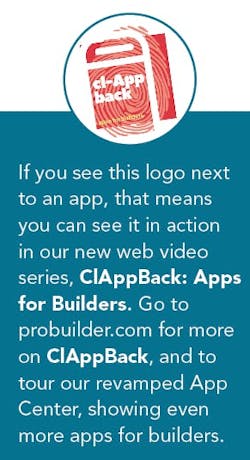There’s a good chance you’ve already used an app on your mobile device today, perhaps to check the weather, navigate an unfamiliar neighborhood, or order some takeout for lunch. What’s more, your customers are probably using apps too, maybe to buy groceries, remotely answer their door, or create a vision board of their dream home. But while there are literally millions of mobile apps for all types of tasks, a growing number focus on professionals, including builders and contractors, to help streamline workflow, enable collaboration, provide access to on-the-job tools and training, and even help with marketing and social media.
Still, and for a variety of reasons, relatively few construction professionals use these apps to complement or improve their productivity, accuracy, and accountability. “Home building has one of the slowest clock speeds for change,” says Tim Costello, president and CEO at BDX, a digital marketer for home builders.
Clock speed refers to the quickness with which an industry adapts to change, and is used to measure how well an industry can anticipate and possibly absorb disruption.
Francein Hansen, residential developer, interior designer, and creator of the Hyve app for managing the design/build process, agrees that introducing apps to builders can be challenging. “But with the innovation of building materials, together with apps, the workflow becomes more streamlined,” she says. “Less time is spent communicating on multiple platforms and fixing mix-ups.”
Costello speculates that most builders think too short-term, focusing on company survival at the expense of looking for innovation through adopting new technologies and software—a choice that can hamper the potential for long-term growth and business sustainability.
He goes so far as to call it the “fog of war”—a metaphor for builders losing sight of the long-term goals that tech can help achieve, warning, “You don’t have time anymore to wait and see how others adopt technology.”
A GENERAL DISCONNECTA likely cause of the industry’s slow adoption of construction-related apps may be lack of common ground. “If some staff are using a tool but others aren’t, it’s going to be a failure,” says Jason LaFleur, senior program manager, emerging technologies and building science at GTI Energy, in Des Plaines, Ill. That disconnect, he says, can send frustration rippling through a team: nonusers may become resistant and isolated, and app users may become resentful of the adoption gap.
Another reason may simply be age. The median age of an NAHB builder member in 2017 was 57, and 57 percent of the association’s builder members are 55 years old or older, with another 24 percent aged 45 to 54. App users trend younger. Those who are 25 to 44 years old spend 15 percent more time using apps than people 45 and older. Nerin Kadribegovic, an architect and partner at Lehrer Architects, in Los Angeles, believes app use will grow as more young people “who have a more instinctual response to technology” enter the industry.
App developers also share culpability. Even when builders are open to using apps, developers aren’t always cognizant of building-specific business needs. “It’s almost like they want us to change our process to integrate into the software, as opposed to the software working and integrating into our business,” says John Leggett, founder and CEO of On Point Custom Homes, in Houston.
Interestingly, some housing professionals are using consumer-centric apps for business-to-business applications with great success, underscoring the growing flexibility of purpose and intermingling of B2B and B2C tools.
Given the housing industry’s relatively slow adoption of most new technologies, choosing apps for business use may be intimidating. Ed Hudson, director of market research for Home Innovation Research Labs, in Upper Marlboro, Md., was startled when a survey following the 2018 International Builders’ Show revealed 77 percent of new-home builders and general contractors weren’t using integrated construction management software and had no plans to do so anytime soon.
With that, Hudson’s research revealed a contingent of builders who believe buyers aren’t looking for tech or apps in their homebuying experience. Anecdotally, this may be true, Hudson says, but looking toward the future, that assumption goes against the general push toward greater technological integration into the human (and homebuying) experience.
Some builders fear choosing the wrong app. Ed Kubiak, VP of construction at Beechen & Dill Homes, in Burr Ridge, Ill., has an app routine for that: Each month, he test drives a new app that’s available or that a colleague has recommended. “If you don’t like an app, delete it,” he says, emphasizing that trying the apps is the most important thing. “We have to think out of the box if we want to change.”
Legacy systems and solutions also loom large. Bigger-volume builders are more likely to use integrated software than are smaller builders. But overall, among building companies, mobile devices aren’t as popular as software used exclusively on desktop or laptop computers. While two-thirds of Hudson’s survey respondents said they use both PC and mobile platforms, none reported using software exclusive to mobile devices.
Yet apps that offer construction-specific teaching tools seem to be attracting a growing number of builders and contractors. Denver-based Construction Instruction’s educational app, for example, has had more than 167,000 downloads as of this writing, with between 14,000 and 18,000 unique visitors per month.
This much is also true: Builders want to improve productivity, marketing, diagnostics and tools, and education. At least one of the following apps may offer a solution that suits those needs.
PRODUCTIVITY
Teams working on a single project may be geographically far-flung, with different tasks and responsibilities, from builder to inspector to client. The need for a central repository of data as a digital home base is one of the most-cited needs by housing pros. If you’re already an app user, likely you’ve called on Buildertrend construction software to enhance productivity. The following apps also aim to help streamline workflow.
• SLACK
This popular business communication tool among Millennials is a cloud-based suite of collaboration tools and services that includes data storage, task management, and a chat client, providing a shared workspace organized and accessible to all. Slack integrates with other enterprise and productivity products, or with a company’s unique products via its open application programming interface (API).
Compatibility: iOS and Android
Free download with in-app purchases
• RAKEN
Daily reporting app Raken captures weather conditions three times per day and attaches that data along with time cards, tasks, and other details to all your daily reports across multiple jobsites. The weather aspect allows project managers to better plan work schedules, keep more detailed records, and defend against any weather-related legal claims. Offline-mode functionality, inspired by gaming and music streaming services, allows users to access the app without an internet connection—a helpful addition for use on the jobsite. Once Wi-Fi connectivity is restored, all project data entered offline is automatically synced.
Compatibility: iOS and Android
Free download with in-app purchases
• HYVE
Hyve users can communicate with in-house teams, and builders can store all project details—including design ideas, budgets, materials lists, product spec sheets, and receipts—in the app to be printed or accessed whenever needed.
Compatibility: iOS and Android
Free download with in-app purchases
• LEAP
Designed to digitize detailed estimates for exterior remodelers, landscapers, and other trades, Leap is advertised as the “first-ever data management application to digitize the in-home sales process.” The app offers detailed reports within moments, populated by users’ product selections; refines product searches; and inputs measurements and quantities. The app also seeks to eliminate estimating errors, resulting in greater cost savings.
Compatibility: iOS
Pricing variable
DIAGNOSTICS + TOOLS
Tools are no longer simply found in a toolbox. Whether it’s augmented or virtual reality visualization—including floor plan builders and heat-mapping software—or schedulers, inspiration boards, educational guides, and air-quality reports, these tools are now curated in apps for builders to help master new skills, perfect current methods, or to simply double-check you’re on the right track.
The Tools Mobile app from FLIR Systems lets users stream live video to their mobile device from any Wi-Fi–enabled FLIR thermal camera. The app can be used to take photos from the camera and integrate the images into reports for customers and co-workers. Users can select unique thermal levels to be scanned, modify the thermal image color palette, and adjust camera parameters. FLIR separately offers a thermal camera for smartphones, priced between $175 and $325.
Compatibility: iOS and Android
Free download with in-app purchases
This intuitive floor plan creator uses augmented reality to increase accuracy. Users can calculate costs and track tasks using customized price lists and can connect to other tools, including lasers and Apple ARKit, to compute the device’s position in real time, providing greater precision.
Compatibility: iOS and Android
Free download with in-app purchases
• HOUZZ
The popular home improvement inspiration app is a favorite of Homes by Dickerson’s marketing manager Julia Reinert. Posting photos on the app, along with vital company details and accolades, has proven useful, she says. The app offers design and architectural photos from homes across the U.S., and Reinert says that as a custom builder, “it is imperative that we stay on top of the latest consumer trends to anticipate the wishes of our clients.” Reinert adds, “It helps [clients] visualize and express their own personal taste.”
Compatibility: iOS and Android
Free download with in-app purchases
• ISCAPE
Landscaper and iScape creator Patrick Pozzuto grew frustrated trying to align the homeowner’s vision with the realities of a project. The iScape augmented reality tool enables users to take a picture of the project site and experience their vision in 3D through drag-and-drop functionality, placing elements such as grass, mulch, and plants, onto the design. Designers and clients can work together, editing the mock-up in real time.
Compatibility: iOS 9.0 or later
Free download with in-app purchases
Providing users with data on live pollution levels, Paris-based startup Plume Labs’ award-winning smart air-quality tracker forecasts can be useful for builders on jobsites subject to air-quality conditions or concerns. The Air Report app predicts air quality levels hourly over a 24-hour span via environmental A.I. and satellite data, and can break down pollution by particular pollutants and by geographical direction in expanded compass views.
Compatibility: iOS 9.0 or later
Free download with in-app purchases
Construction Instruction project manager Deirdre Damron says the Construction Instruction app was born on the road more than a decade ago. The company’s principals frequently field builder questions at educational seminars in the U.S. and Canada, and the app became a leave-behind at these sessions. It includes construction videos, customizable 3D building animations, building-science articles, and installation details. Users can save pertinent information to a Favorites folder for easy access at any time and can send questions to the company through the app.
Compatibility: iOS 9.0 or later
Free download with in-app purchases
MARKETING
The way a company uses, or doesn’t use, technology can speak volumes to a homebuyer, as can a firm’s social media presence (or absence). Will Duderstadt, vice president of digital marketing at M/I Homes, in Columbus, Ohio, says builders inherit all of the expectations that buyers have developed from shopping with other brands such as Amazon or Zappos. A strong digital presence is no longer important for some industries more than others; it’s now essential for all businesses in all industries.
While larger builders’ digital marketing campaigns may be powered by an in-house or contract team, that may not be feasible for a smaller builder. For marketing inspiration, Duderstadt recommends builders study e-commerce sites within and beyond the home building industry. These apps help bring the visual power of digital marketing into the palm of a builder’s hand.
Created by builders hoping to help their peers bolster their social media efforts, this app encourages homebuyers to talk about a builder on social media. My Home’s Story allows buyers and builders to link their photos from a project to their social media accounts. The app offers increased search engine optimization (SEO) by tracking traffic and shares and is designed to boost engagement and online leads.
Compatibility: iOS and Android
$50 per month per agent, or $500 annually per agent
• CANVA
A graphics tool for non-designers, Canva lets users create graphics for social media, marketing campaigns, or websites using its drag-and-drop interface. There are thousands of layouts to choose from, including letterhead, advertisements, photo collages, social media posts, business cards, and presentations. Users can create their own brand-customized templates with a paid membership, allowing them to save brand colors, logos, and fonts in the app.
Compatibility: iOS and Android
Free download with in-app purchases
Canva for Work: $12.95 per month
Canva Enterprise: pricing available upon request
MANUFACTURER APPS
Custom selections, on-site proposal creation, and downloadable installation and warranty documents are just a few of the latest offerings available in manufacturer apps. Of the wide variety of such apps available for builders and homebuyers, these stand out.
Using Apple ARKit technology, Cambria AR, the engineered stone manufacturer’s augmented reality app, allows users to virtually map countertops and overlay Cambria designs, replacing the existing surface with the virtual design. Users can even share the images and designs online with friends, clients, and family.
Compatibility: iOS and Android
Free download with in-app purchases
• STANLEY
The Stanley Smart Measure Pro provides fast, accurate measurements of areas photographed on mobile devices. This time-saving tool instantly provides correct dimensions and accurate estimations of how much material will be needed to complete a project. File export capability includes PDF and JPG formats.
Compatibility: iOS and Android
Free download with in-app purchases
Weyerhaeuser has a variety of apps and software for builders. The Parallam Plus Deck Beam Sizer app helps builders and trades quickly size the proper carrying beam for a deck system. A complete library of product literature can be found on its Document Library Mobile App.
Compatibility: iOS and Android
Free download
WHAT'S NEXT?
Augmented and virtual reality tools are growing in prominence today and are widely considered to be a significant influencer in the housing industry’s future. Evan Bost, director of marketing and building performance at Bost Custom Homes, in Cary, N.C., says buyers’ yen for visual tech is a driving force. “Buyers are interested in seeing 3D models before finalizing their design decisions,” though, he adds that the cost of such renderings can be steep. Yet, Bost believes that VR modeling will become cheaper as the technology continues to develop.
The intuitive, artistic side of technology is also ripe for tech exploration. Architect Nerin Kadribegovic says, “I want to be able to connect to computer software that can directly translate my thoughts into a digital model. That will be revolutionary. It’s just a matter of time.”
“Think Google Analytics for all marketing efforts in one place,” posits marketing manager Julia Reinert. Her focus is on quantifying data use by generation to create a real-time return on investment, and to predict how that may shape housing’s future. Reinert sees such capability as something of a tech divining rod—analyzing Millennial tech use in homebuying to subsequently incorporate new ideologies into a company’s offerings and culture.
Software developers continue to create and refine apps, and new functionality will continue to flourish. As of 2019, apps have become ubiquitous. What will builders and homes be capable of in five, 10, or 20 years? In all likelihood, there will be more, rather than fewer apps to tap.


